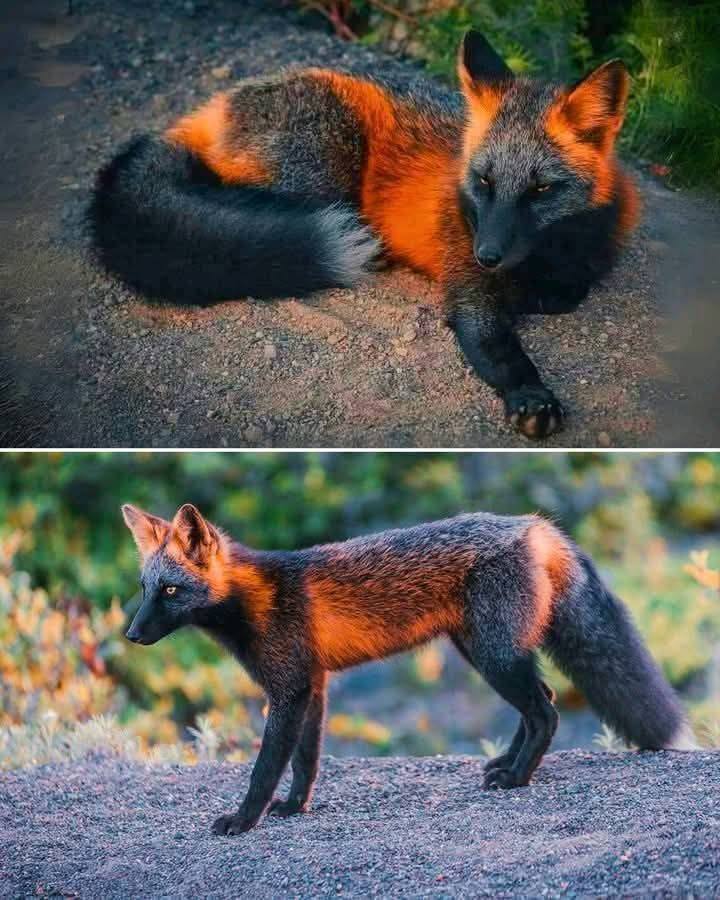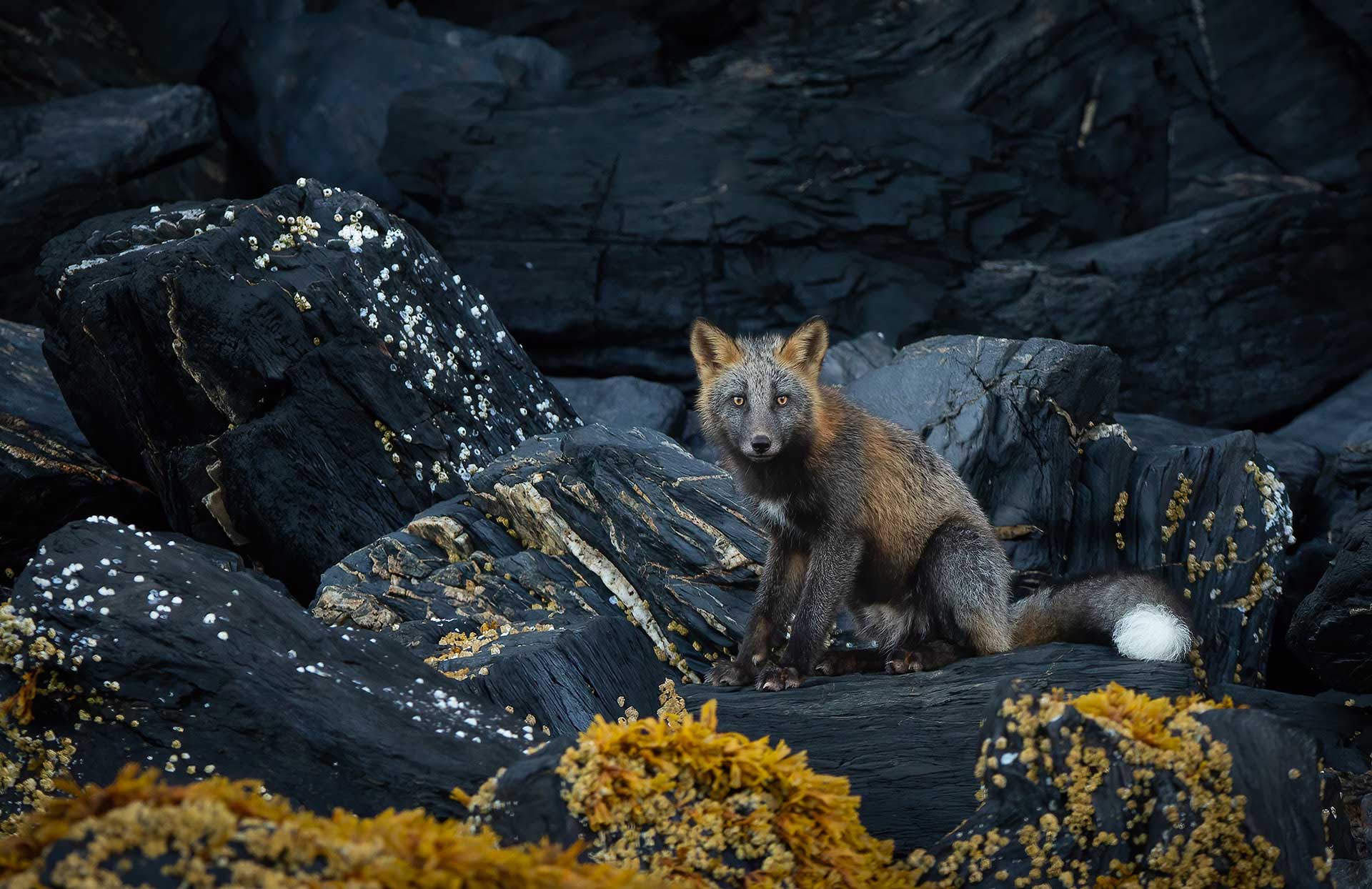The Enigmatic Beauty of the Cross Fox: Nature’s Striking Masterpiece

Nature never fails to surprise us with its endless palette of colors, patterns, and adaptations. Among the most breathtaking of its creations is the Cross Fox—a mesmerizing and rare variation of the red fox, bearing a rich tapestry of dark charcoal black, russet orange, and ash grey. With its piercing eyes and coat that seems to glow under sunlight, the Cross Fox stands out not just for its beauty, but also for its ecological significance, behavioral intelligence, and symbolic meaning throughout history.
This article explores the biology, behavior, genetics, and cultural impact of the Cross Fox—unveiling the story of one of nature’s most enigmatic creatures.

What is a Cross Fox?
The Cross Fox (Vulpes vulpes) is not a separate species, but a color morph of the common red fox. While the red fox is widespread across North America, Europe, Asia, and parts of North Africa, the Cross Fox is rarer and typically found in northern North America, especially Canada, Alaska, and parts of the northern United States.
It gets its name from the distinct dark cross-shaped marking that runs down its back and across its shoulders, creating the illusion of a “cross.” Its fur often blends deep black legs and face with reddish-orange sides and back, making it look like it stepped out of a fantasy novel.
The Science Behind the Color
The unique coloring of the Cross Fox comes down to genetics. Fox fur color is influenced by multiple genes that control pigmentation. The red fox has several naturally occurring morphs:
-
Red fox – the most common, with bright orange-red fur and white underbelly.
-
Silver fox – nearly black with silver-tipped fur; very rare.
-
Cross fox – intermediate between red and silver, featuring blackish fur on the back and shoulders, with orange flanks.
These variations are part of what is called melanism—an increased amount of the dark pigment melanin. In the Cross Fox, partial melanism creates a layered color pattern, giving it a unique and shadowy appearance.
Cross foxes were once believed to be a separate species by early trappers and indigenous peoples due to their distinct look, but they are now classified simply as a color variation within the red fox population.
Habitat and Distribution
Cross foxes prefer forest edges, tundra zones, and boreal regions, especially in Canada and the northern United States. Their thick fur helps them survive extremely cold climates, and their fur color provides effective camouflage against the forest floor and snowy surroundings.
They can also be found in areas where forests meet open meadows—a transitional landscape known as an ecotone, which offers abundant prey like rodents, birds, insects, and fruits.
Like other red foxes, Cross Foxes are highly adaptable. They are capable of surviving in various habitats including woodlands, farmlands, and even near human settlements.

Behavior and Intelligence
The Cross Fox, like all red foxes, is highly intelligent and resourceful. It is primarily a solitary animal, most active during the twilight hours (crepuscular), though it may hunt at night or during the day depending on food availability.
Key behaviors include:
-
Hunting technique: Foxes use a pouncing method to catch prey, often leaping high into the air and landing with precision. They can hear small rodents beneath the snow using their acute hearing.
-
Food caching: They bury surplus food for later consumption.
-
Communication: Foxes communicate through a range of vocalizations (over 20 different sounds), body language, and scent marking.
-
Parental care: Both male and female foxes may participate in rearing the kits (baby foxes).
Cross Foxes do not differ behaviorally from their red fox counterparts, but anecdotal reports suggest they may be slightly more cautious or elusive—perhaps due to their rarity and tendency to avoid conflict.
The Cross Fox in History and Culture
Throughout history, the Cross Fox has held a place of mystique and reverence in various cultures.
Indigenous Beliefs:
-
Among some Native American tribes, the Cross Fox was considered a spirit animal or messenger between worlds, symbolizing cunning, adaptability, and transformation.
-
Its unique appearance led to myths that it was a hybrid creature or a magical guardian of the forest.
Fur Trade:
In the 18th and 19th centuries, Cross Fox pelts were highly valued in the fur trade. They were considered more desirable than red fox pelts but slightly less valuable than the rare silver fox. The Hudson’s Bay Company regularly listed Cross Fox pelts in their inventories, sometimes fetching higher prices due to their exotic appearance.

Symbolism in Modern Times:
Today, the Cross Fox remains a symbol of beauty in rarity, genetic diversity, and the untamed wild. Photographers and wildlife enthusiasts cherish sightings of this rare animal, often describing it as a “living ember in the woods.”
Conservation and Challenges
Although the red fox species as a whole is not endangered, and is even flourishing in many regions, specific color morphs like the Cross Fox are quite rare and thus more vulnerable to environmental pressures.
Threats include:
-
Habitat loss from logging and urban expansion.
-
Climate change, which affects prey populations and seasonal behavior.
-
Trapping, although reduced in modern times, still occurs in some regions.
Because they are so rarely seen, cross foxes are not individually tracked or protected in most countries. However, efforts to preserve wilderness areas, promote ethical wildlife photography, and educate the public about rare morphs contribute indirectly to their protection.
The Genetic Riddle
One of the most fascinating aspects of the Cross Fox is how its genes are inherited. The color morph is not purely dominant or recessive, meaning that two red foxes can produce a cross fox, and two cross foxes might produce a red or silver fox. This unpredictable outcome adds to the animal’s mystery.
The gene responsible for melanism in red foxes is incompletely dominant, and when paired in certain combinations, can produce the various morphs. The complexity of coat color genetics in foxes has been a subject of scientific interest for decades, especially due to studies at the Russian fox domestication project which also explored how genetics affect behavior.
Capturing the Cross Fox — Through the Lens
The Cross Fox has become a favorite subject for wildlife photographers, particularly in regions like Alaska, Yukon, and British Columbia. The best time to spot one is usually early morning or late evening, when foxes are more active and lighting highlights their vivid fur.
Tips for observing or photographing Cross Foxes:
-
Use a long lens and remain quiet and still.
-
Avoid baiting or approaching too closely.
-
Respect nesting areas, especially during denning season.
-
Learn local laws about wildlife photography and safety.
The reward for patience is often a once-in-a-lifetime image—an ethereal blend of shadow and flame in a living creature.
A Symbol for Conservation
In many ways, the Cross Fox has become a flagship species for appreciating and conserving biodiversity. It reminds us that even within one species, there lies a rich world of variation that deserves attention and protection.
Seeing a Cross Fox in the wild is not just a thrill—it is a reminder of what’s still untouched, what still thrives in hidden corners of the world.
By protecting habitats, respecting wildlife, and learning about species like the Cross Fox, we take a step toward preserving the mystery and majesty of the natural world for future generations.
Nature’s Flame in Fur
The Cross Fox walks the earth like a flickering ember — bright, rare, and fleeting. It defies the idea that nature is uniform. It challenges us to look closer, to celebrate the details, the differences, and the wonders that may go unnoticed.
Whether seen in a photograph or — if you’re lucky — in the wild, the Cross Fox is a visual and biological marvel. It is the perfect reminder that not all beauty is common, and that nature still holds secrets waiting to be found, studied, and protected.











